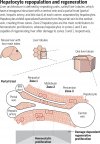Herbal and Dietary Supplements-Induced Liver Injury
Background: Herbal and dietary supplements (HDS) consumption, a growing cause of hepatotoxicity, is a common practice among Latin-American populations.
Objectives: To evaluate clinical, laboratory features and outcome in HDS-hepatotoxicity included in the Latin America-Drug Induced Liver Injury (LATINDILI) Network.
Material and methods: A total of 29 adjudicated cases of HDS hepatotoxicity reported to the LATINDILI Network from October 2011 through December 2019 were compared with 322 DILI cases due to conventional drugs and 16 due to anabolic steroids as well as with other series of HDS-hepatotoxicity.
Results: From 367 DILI cases, 8% were attributed to HDS. An increasing trend in HDS-hepatotoxicity was noted over time (p=0.04). Camellia sinensis, Herbalife® products, and Garcinia cambogia, mostly used for weight loss, were the most frequently adjudicated causative agents. Mean age was 45 years (66% female). Median time to onset was 31 days.
Patients presented typically with hepatocellular injury (83%) and jaundice (66%). Five cases (17%) developed acute liver failure. Compared to conventional medications and anabolic steroids, HDS hepatotoxicity cases had the highest levels of aspartate and alanine transaminase (p=0.008 and p=0.021, respectively), had more re-exposure events to the culprit HDS (14% vs 3% vs 0%; p=0.026), and had more severe and fatal/liver transplantation outcome (21% vs 12% vs 13%; p=0.005). Compared to other DILI cohorts, less HDS hepatotoxicity cases in Latin America were hospitalized (41%).
Conclusions: HDS-hepatotoxicity in Latin-America affects mainly young women, manifests mostly with hepatocellular injury and is associated with higher frequency of accidental re-exposure. HDS hepatotoxicity is more serious with a higher chance of death/liver-transplantation than DILI related to conventional drugs.
Bessone F, García-Cortés M, Medina-Caliz I, et al. HERBAL AND DIETARY SUPPLEMENTS-INDUCED LIVER INJURY IN LATIN AMERICA: EXPERIENCE FROM THE LATINDILI NETWORK. Clin Gastroenterol Hepatol. 2021 Jan 9:S1542-3565(21)00013-6. doi: 10.1016/j.cgh.2021.01.011. Epub ahead of print. PMID: 33434654. https://www.cghjournal.org/article/S1542-3565(21)00013-6/pdf
Background: Herbal and dietary supplements (HDS) consumption, a growing cause of hepatotoxicity, is a common practice among Latin-American populations.
Objectives: To evaluate clinical, laboratory features and outcome in HDS-hepatotoxicity included in the Latin America-Drug Induced Liver Injury (LATINDILI) Network.
Material and methods: A total of 29 adjudicated cases of HDS hepatotoxicity reported to the LATINDILI Network from October 2011 through December 2019 were compared with 322 DILI cases due to conventional drugs and 16 due to anabolic steroids as well as with other series of HDS-hepatotoxicity.
Results: From 367 DILI cases, 8% were attributed to HDS. An increasing trend in HDS-hepatotoxicity was noted over time (p=0.04). Camellia sinensis, Herbalife® products, and Garcinia cambogia, mostly used for weight loss, were the most frequently adjudicated causative agents. Mean age was 45 years (66% female). Median time to onset was 31 days.
Patients presented typically with hepatocellular injury (83%) and jaundice (66%). Five cases (17%) developed acute liver failure. Compared to conventional medications and anabolic steroids, HDS hepatotoxicity cases had the highest levels of aspartate and alanine transaminase (p=0.008 and p=0.021, respectively), had more re-exposure events to the culprit HDS (14% vs 3% vs 0%; p=0.026), and had more severe and fatal/liver transplantation outcome (21% vs 12% vs 13%; p=0.005). Compared to other DILI cohorts, less HDS hepatotoxicity cases in Latin America were hospitalized (41%).
Conclusions: HDS-hepatotoxicity in Latin-America affects mainly young women, manifests mostly with hepatocellular injury and is associated with higher frequency of accidental re-exposure. HDS hepatotoxicity is more serious with a higher chance of death/liver-transplantation than DILI related to conventional drugs.
Bessone F, García-Cortés M, Medina-Caliz I, et al. HERBAL AND DIETARY SUPPLEMENTS-INDUCED LIVER INJURY IN LATIN AMERICA: EXPERIENCE FROM THE LATINDILI NETWORK. Clin Gastroenterol Hepatol. 2021 Jan 9:S1542-3565(21)00013-6. doi: 10.1016/j.cgh.2021.01.011. Epub ahead of print. PMID: 33434654. https://www.cghjournal.org/article/S1542-3565(21)00013-6/pdf


